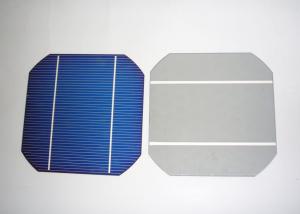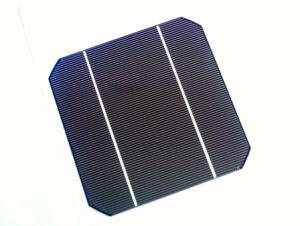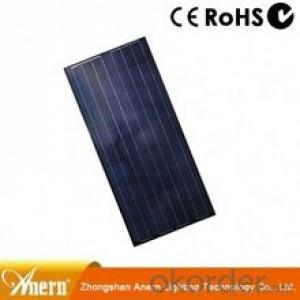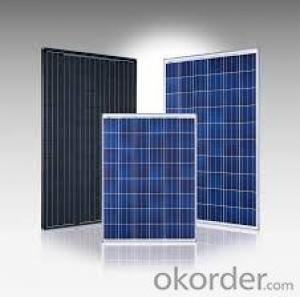2016 Hot Sale Mono Solar Cells 2BB/3BB 156 mm X 156 mm Products
- Loading Port:
- Ningbo
- Payment Terms:
- TT or LC
- Min Order Qty:
- 4200 watt
- Supply Capability:
- 600000 watt/month
OKorder Service Pledge
OKorder Financial Service
You Might Also Like
Specifications of Mono Solar Cells
Format : 156 mm × 156 mm ± 0.5 mm
Thickness: 210 μm ±40 μm
Front (-) : 1.5mm bus bars (silver),blue anti-reflection coating (silicon nitride)
Back (+) : 2.5mm wide soldering pads (silver) back surface field (aluminium)
Electrical Characteristic of Mono Solar Cells
Efficiency (%) | Pmpp (W) | Umpp (V) | Impp (A) | Uoc (V) | Isc (A) | FF (%) |
18.35 | 4.384 | 0.526 | 8.333 | 0.63 | 8.877 | 78.39% |
18.20 | 4.349 | 0.526 | 8.263 | 0.63 | 8.789 | 78.54% |
18.05 | 4.313 | 0.525 | 8.216 | 0.63 | 8.741 | 78.32% |
17.90 | 4.277 | 0.524 | 8.161 | 0.629 | 8.713 | 78.04% |
17.75 | 4.241 | 0.523 | 8.116 | 0.629 | 8.678 | 77.70% |
17.60 | 4.206 | 0.521 | 8.073 | 0.628 | 8.657 | 77.36% |
17.45 | 4.170 | 0.519 | 8.039 | 0.628 | 8.633 | 76.92% |
17.30 | 4.134 | 0.517 | 8.004 | 0.626 | 8.622 | 76.59% |
17.15 | 4.098 | 0.516 | 7.938 | 0.625 | 8.537 | 76.80% |
17.00 | 4.062 | 0.512 | 7.933 | 0.625 | 8.531 | 76.18% |
16.75 | 4.002 | 0.511 | 7.828 | 0.625 | 8.499 | 75.34% |
16.50 | 3.943 | 0.510 | 7.731 | 0.625 | 8.484 | 74.36% |
Advantage of Mono Solar Cells
1. High efficiency and High power.
2. Long-term electrical stability.
3. Lowest price and Fastest delivery.
4. Good quality and best service.
5. Bulk supply
6. Trusted Warranty
7. Big Sale
8. More than 25 years on the lifetime.
Usage and Applications of Mono Solar Cells
Solar cells are often electrically connected and encapsulated as a module.
Photovoltaic modules often have a sheet of glass on the front (sun up) side, allowing light to pass while protecting the semiconductor wafers from abrasion and impact due to wind-driven debris, rain, hail, etc.
Solar cells are also usually connected in series in modules, creating an additive voltage.
Connecting cells in parallel will yield a higher current;our solar cells have passed IEC Certification. With high quality and stable quality.
Our Cells can greatly improve the performance of Solar Modules.
Packaging & Delivery of Mono Solar Cells
Carton Box Package and Deliver by air. It should be noticed that it should be avoid of water, sunshine and moist.
Factory Picture of Mono Solar Cells
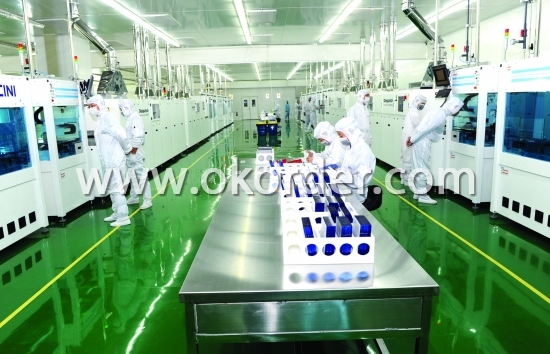
Package Picture of Mono Solar Cells

In the long term, despite the current cost of a single crystal is high, but the cost of the single crystal pulling and other non-silicon costs will gradually close to the ingot and other non-cost polycrystalline silicon in future, therefore the downside of mono solar cells’ cost is greater than polycrystalline. At the same time the existing P-type cell conversion efficiency has been gradually facing a bottleneck, while the new N-type monocrystalline cells (conversion efficiency to 22% to 24%) is already in production, costs and wait until the technology to further breakthroughs, is expected to gradually spread. So the future is expected to gradually increase the amount of a single crystal production, the production of photovoltaic silicon cells account for world dominance.
Polycrystalline silicon solar cell production analysis
According to statistics, 2003--2012 global polysilicon solar cell production increased year by year, from 2003 to 2012 grew 467MW 17292MW, the annual compound growth rate of more than 40% from the market share of various types of solar cells see 2003 - 2005 period the proportion of polycrystalline silicon cells decreased from 63-57% in 2006 - in 2012 it remained stable at 45% - 50%. The first half of 2013, global polysilicon solar cell production reached 9432MW.
Polycrystalline silicon solar cell market outlook
The first half of 2013, global polysilicon production reached 100,000 tons, crystalline silicon solar cell production of 18GW, polycrystalline silicon consumes about 11 million tons, because the downstream PV companies continue to digest inventory, the polysilicon market supply and demand balance. From a market share point of view, 2012 - May 2013, the market share is still slightly higher than the polycrystalline silicon solar cell silicon solar cells. This highlights the current status of polycrystalline silicon photovoltaic cell technology market is still one of the two major technology firms.
But according to the performance of domestic companies since 2012, mono solar cells 2BB/3BB technology is better than the overall performance of the company polysilicon companies. The current global PV market has not yet fully grown; mono solar cells 2BB/3BB and polycrystalline technology has living space. Short and medium term, polysilicon will remain relatively dominant. From the long-term trend, mono solar cells 2BB/3BB will be able to share half of the market space at least.
- Q:Can solar cells be used in areas with high pollution?
- Yes, solar cells can be used in areas with high pollution. While pollution can reduce the efficiency of solar cells, they can still generate electricity in such areas. However, regular cleaning and maintenance may be required to ensure optimal performance.
- Q:How do solar cells perform in areas with high levels of snowfall?
- Solar cells generally do not perform optimally in areas with high levels of snowfall. The accumulation of snow on the surface of solar panels can significantly reduce their efficiency by blocking sunlight and preventing the cells from generating electricity. Regular snow removal or tilting the panels at an angle can help mitigate this issue, but it may still impact their overall performance in such regions.
- Q:Can solar cells be used in mining operations?
- Yes, solar cells can be used in mining operations. They can provide a reliable and sustainable source of electricity for various mining activities, such as powering equipment, lighting, and ventilation systems. Solar energy can significantly reduce the dependence on fossil fuels in mining operations, leading to lower operational costs and reduced environmental impact.
- Q:Can solar cells be used in drones?
- Yes, solar cells can be used in drones. Solar-powered drones have been developed and are being used for various applications. They use solar cells to convert sunlight into electrical energy, which can be used to power the drone's motors and other electronic components. This allows for longer flight times and reduces the need for frequent battery replacements or recharging.
- Q:I have a turnkey solar power project starting in 6 months, now we are searching the market in south China to find the best solar cells manufacturers. Any professional suggestion or recommendation?
- In south China, you will have more resources than in north China, because there are many solar cell factories over there, which means you get to have more choice to select from.
- Q:How do solar cells perform in areas with high levels of sandstorms?
- Solar cells may face challenges in areas with high levels of sandstorms. The sand particles in the air during a sandstorm can potentially cover the surface of solar panels, reducing their efficiency. Moreover, sandstorms may also cause physical damage to the solar cells and their supporting structures. Therefore, it is crucial to implement proper maintenance and protection measures, such as regular cleaning and the use of protective coatings, to ensure optimal performance of solar cells in areas prone to sandstorms.
- Q:How do solar cells impact water resources?
- Solar cells have a positive impact on water resources as they do not require water for their operation, unlike traditional power plants that heavily rely on water for cooling purposes. This reduces the strain on water resources and helps in conserving them for other essential needs.
- Q:Can solar cells be used in powering drones?
- Yes, solar cells can be used in powering drones. Solar panels can be mounted on the surface of drones to convert sunlight into electrical energy, which can then be used to power the drone's motors and other electronic components. This enables longer flight times and reduces the reliance on traditional battery power. However, the efficiency of solar cells and limited surface area on drones may present challenges in generating sufficient power for certain drone applications.
- Q:Can solar cells be used for powering remote weather stations?
- Yes, solar cells can be used to power remote weather stations. Solar cells convert sunlight into electricity, which can be used to power various devices, including weather stations. This makes them an ideal and sustainable solution for providing power to remote locations where traditional grid connectivity may not be available.
- Q:Can solar cells be used to power outdoor signage?
- Yes, solar cells can be used to power outdoor signage. Solar panels or cells can be installed on or near the signage to harness sunlight and convert it into electricity. This renewable energy source can provide a sustainable and cost-effective solution for powering outdoor signage, reducing dependence on traditional power sources.
1. Manufacturer Overview |
|
|---|---|
| Location | Zhejiang, China |
| Year Established | 2008 |
| Annual Output Value | Above US$ 320 Million |
| Main Markets | Australia; Asia; South East Asia; South America; North America; Europe; Africa |
| Company Certifications | ISO 9001:2008; CE; TUV; UL |
2. Manufacturer Certificates |
|
|---|---|
| a) Certification Name | |
| Range | |
| Reference | |
| Validity Period | |
3. Manufacturer Capability |
|
|---|---|
| a)Trade Capacity | |
| Nearest Port | Ningbo, China |
| Export Percentage | 45% - 50% |
| No.of Employees in Trade Department | 200-300 People |
| Language Spoken: | English; Chinese |
| b)Factory Information | |
| Factory Size: | Above 10,000 Square meter |
| No. of Production Lines | 8 |
| Contract Manufacturing | OEM Service Offered; Design Service Offered |
| Product Price Range | Average |
Send your message to us
2016 Hot Sale Mono Solar Cells 2BB/3BB 156 mm X 156 mm Products
- Loading Port:
- Ningbo
- Payment Terms:
- TT or LC
- Min Order Qty:
- 4200 watt
- Supply Capability:
- 600000 watt/month
OKorder Service Pledge
OKorder Financial Service
Similar products
New products
Hot products
Hot Searches
Related keywords

